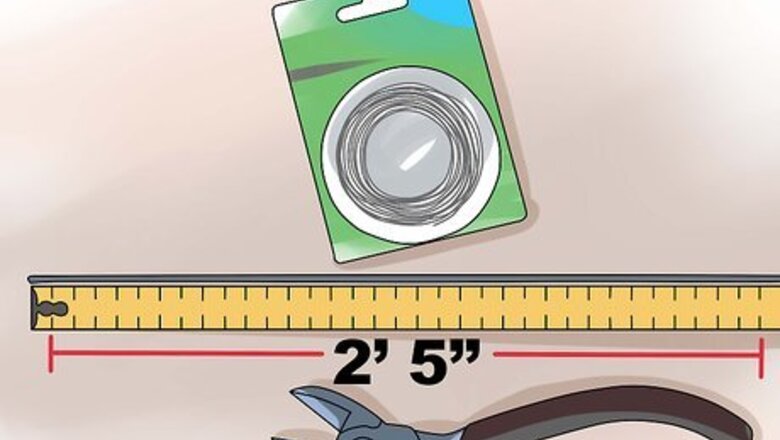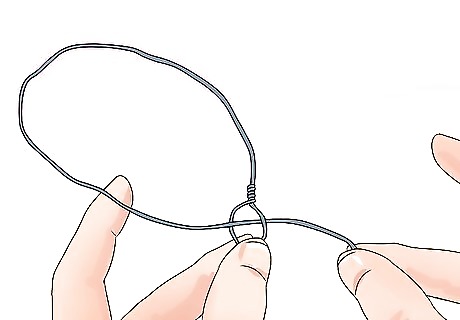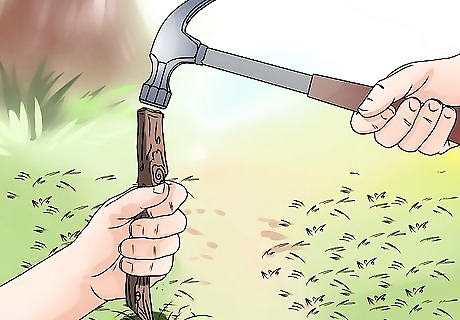
views
Building a Free-Standing Snare

Cut a piece of wire for your snare. You want roughly 2.5 feet (0.8 m) of wire to create your snare. While you can use any long, bendable string, usually a steel or aluminum wire works best.

Create a small loop at the end of the wire. Bend one end of the wire around your finger to create a small loop roughly 1 inch (3 cm) across. The end of the wire will bend back on itself so there are roughly 2–3 inches (5–8 cm) of extra wire at the bottom of the loop. This is your slip-knot loop.

Twist the end of the wire to hold it in place. Wrap the excess wire from the loop around the wire at least 5-6 times to snugly secure them together. Imagine braiding two pieces of rope or hair snuggly together. This is the most important part of the trap, and the loop needs to be strongly attached. When done it will resemble a balloon on a string or the head of a needle. Put a pencil into the loop and then try to pull it apart. It should hold firm under a fair amount of pressure. You can use pliers to clamp the wires together for added stability.

Take the opposite end of the wire and push it through your slip-knot loop. Feed the opposite end of your wire into the small loop you just made, like threading string through the top of a needle. Your wire will now resemble a large circle with the both ends of the wire close together.

Pull the end of the wire through your slip-knot loop to make a noose. Keep pulling until the wire circle is roughly the size of your fist, around 6–7 inches (15–18 cm) across. Your wire will look like a yo-yo on the end of a string, with the wire on one end and your small noose on the other. The bottom wire should meet the noose at the slip-knot loop.

Drill a small hole through a stake or wooden post. This will keep your trap in place once a rabbit runs through it. The hole should be roughly 8–10 inches (20–25 cm) off of the ground once you secure the post in the ground.

Secure the wire to the stake. Feed 3–4 inches (7.6–10 cm) of wire through the hole in the post and then wrap it around so that it meets the rest of the wire. Braid the end of the wire to the rest of the wire, making a balloon shape like the one used to make the slip-knot loop. You can also tie the wire to the post, or use a staple gun to secure it to the wood. You want to have roughly a foot of wire between the post and your snare. Tug on your wire to make sure it is attached to the post and does not come out easily.

Drive the post into the ground. Find a small path where you’ve seen rabbits in the past and secure the post into the ground. Use a hammer to firmly stick the trap in place – it shouldn’t move or come out easily. You can also play your trap near fences or gardens, at the edge of high grass, or in the underbrush. Make sure the post is driven into the ground firmly – if the rabbit can pull it out of the ground they will escape.

Angle the noose 6–8 inches (15.2–20.3 cm) above the ground. Think of your noose as a target you want the rabbit to hit mid-jump. When the rabbit hops through the loop, it will pull the noose tightly shut, killing the rabbit.
Building a Hanging Snare

Cut a 2.5ft piece of wire, rope, or cord. This is the wire that will capture and kill the rabbit in your snare, so it needs to be strong enough to hold the animal. While you can use any long and bendable wire, a thin metal wire works best. While easier to work with, rabbits can chew threw many thin ropes and cords, making metal the best option.

Create a small loop at the end of the wire. Bend one end of the wire back on itself to create a simple loop, no bigger than an inch. You can wrap the wire around your finger to get the shape and size right. There should be roughly 2–3 inches (5–8 cm) of extra wire at the bottom of the loop. This is your slip-knot loop.

Twist the end of the wire at the bottom of the loop to hold it in place. Wrap the excess wire from the loop around the wire at least 5-6 times to snugly secure them together. This is the most important part of the trap, and the loop needs to be strongly attached. When done, it will resemble a balloon on a string. The best way to test the strength of your loop is to put a pencil into the loop and then pull it apart. If the loop comes undone then you should retwist the wire to create a stronger loop. Use pliers to clamp the wires together for added stability if you need it.

Take the opposite end of the wire and push it through your slip-knot loop. Feed the opposite end of your wire into the small loop you just made. Your whole wire will now resemble a large circle.

Keep pulling the end through your slip-knot loop to make a noose. Pull the end of the wire through the loop, shrinking your circle until it is the size of your fist, roughly 6–7 inches (15–18 cm) across. Your wire will look like a yo-yo on the end of a string.

Place a branch, felled tree, or bar horizontally over the ground. It should be elevated roughly a foot off the dirt and placed in a narrow corridor, such as a small footpath or a trampled trail in the forest. Your snare will hang from this to trap the rabbit. Felled trees, low hanging branches, or iron bars will all work. Make sure your bar is secured or heavy enough that a small rabbit couldn’t pull it away.

Tie your snare to the bar. The loop should be hanging from the trap so that it is 7–8 inches (17.8–20.3 cm) off of the ground. Your trap will resemble a noose hanging from a rafter or bar. As the rabbit jumps through the loop its weight will pull the loop tightly shut and kill the animal.

Create barriers to force rabbits towards your trap. Using large branches, block off the space underneath and to the sides of your snare, forcing them to jump through your loop. You want to block off all the space except the one in your snare.
Placing Your Traps Effectively

Set up traps near fence holes. One of the best places to put a trap is in the holes rabbits use to enter your property. If your fence has openings that rabbits use regularly, fit the loop of your snare right in the hole and wait for them to come back.

Place traps near small, beaten paths. Rabbit trails will show grass that has been stepped down repeatedly, little tracks in the dirt, and patches of mud. If you could walk through it, then rabbits will likely use it at some point to navigate the forest. Look for openings in tall grass, muddy paths, or known rabbit holes.

Set multiple traps for the best results. Trapping is a numbers game; the more snares you set, the more rabbits you will get. Separate them by a few hundred yards to increase your chances of successful capturing.

Make sure your snares are the right height. The snare works by catching the rabbit mid-hop so that it pulls the snare tight as it returns to the ground. You want your snare to be 6–8 inches (15.2–20.3 cm) off of the ground. Remember that a rabbit needs to fit its head and ears into the trap. Most rabbits are 6–7 inches (15.2–17.8 cm) big from nose to ear tips.

Return to your traps after 24 hours. Constantly checking in on your trap scares away wildlife, so be patient. After one day has passed, return to the trap to check if it caught anything. If not, leave and return the next day. If you have still not caught anything, adjust the height of the snare or move it.



















Comments
0 comment